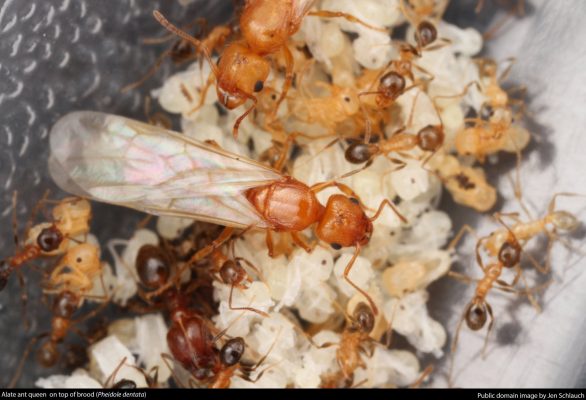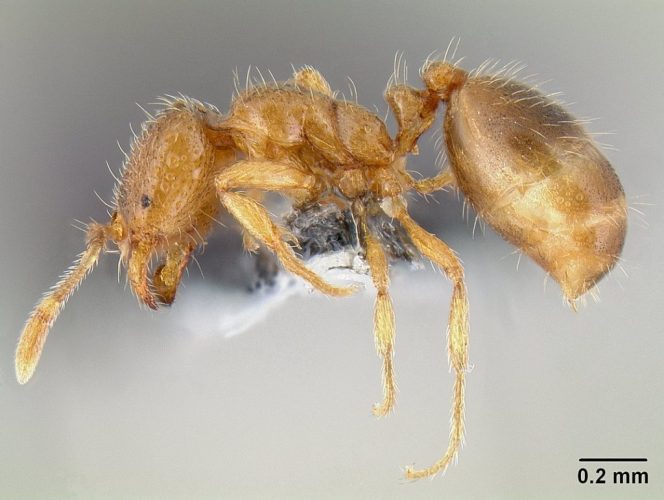It can sometimes feel like no matter what you do, ants will always return. This is a feeling that no one should have to experience.
Grease ants are one of the pesky insects that are so small they can be hard to control due to their ability to invade small areas.
Don’t worry; I’m here to help.
In this post, I will help you identify grease ants and outline eight steps you can follow to get rid of them every time.
Let’s get started.
What Are Grease Ants?

Grease ants are one of the smallest species of ants measuring between 0.05 and 0.08 inches long.
For reference, this is about 1/5th the size of an aspirin or about ⅓ the size of a short grain of rice.
They typically build their nest near other ant colonies because they commonly feed and steal food from other ant colonies.
This is the reason they are commonly referred to as “theif ants.”
Contrary to their name they eat more than grease. Grease ants are actually omnivorous meaning they will eat anything they can get their hands on including other species of ants and dead insects.
What Do Grease Ants Look Like?

Grease ants are a very small species of ants that measures between 0.05 inches and 0.08 inches.
They can vary from a light yellow to a dark brown. In many cases, the head and abdomen of the grease ant are slightly darker than the rest of their body.
The abdomen typically has three to four darker stripes making the abdomen look segmented.
The body of a grease ant has small hairs most noticeable on the head and abdomen.
- Size: 0.05 inches (1.5mm) to 0.08 inches (2.5mm)
- Color: Grease ants vary in color from dark yellow to light brown. In some cases, grease ants are a dark brown but it’s uncommon. It also common for thief ants to have a darker abdomen and head than the rest of their body.
- Abdomen: Large oblong abdomen with dark straps toward the end.
- Thorax: The thorax has no spines and has two nodes
- Antenna: 10 segmented antennae with a two-segmented club at the end
- Hairs: Small hairs located on their body but most noticeable on abdomen and head.
What Do Grease Ants Eat?
Grease ants are omnivores meaning they will eat almost anything they can infest. Grease ants will eat grease, protein, sugar, human food, other ants, dead insects, fruits, meat, cheese, and oil.
Contrary to their name, they don’t only eat grease, although they are attracted to grease. Grease ants, unlike some species of ants, don’t stick to a specific source of food.
What Attracts Grease Ants?
Grease ants are attracted to most potential food sources and other species of ants.
They often target areas with ant colonies already established. They will typically invade the other nest to steal food and attack the other ant colony.
Grease ants are also attracted to any food source that they can potentially infest. This includes grease, protein, oil, sugar, carbs, fruit, protein, cheese, or dead insects.
Grease ants are also attracted indoors to the warmth and shelter during winter. Grease ants will hide near kitchens indoors to remain close to potential food sources.
These ants are commonly found hiding inside walls, under floorboards, inside door moldings and sills, behind baseboards.
During the hotter months, grease ants are also attracted to sources of water. You will commonly find them near water sources such as leaky faucets, pipes, or sprinklers. These water sources will provide the water they need to survive.
Do Grease Ants Bite?
No, grease ants don’t bite. Even if they did bite, likely, you would hardly feel anything due to their size and small jaw.
Another common concern when seeing grease ants is the stinger that grease ants have at the end of their abdomen.
Like their jaw, even if they did use their stinger, it’s not strong enough to break the skin or cause any harm to humans.
What Ants Look Like Grease Ants?
Grease ants are most commonly confused with sugar ants. When people use the term sugar ants, they often refer to a group of ant species that eat sugar.
Indoor and outdoor ants both eat sugar, which means using the term sugar ants can be confusing.
The most common species of sugar ants that you will find in your home are the:
- Pharaoh ants
- Odorous Ant
- Pavement Ants
Grease Ants vs Sugar Ants
Pharaoh ants are the type of ant species that most resembles a grease ant. These pants look very similar in appearance, and they also tend to consume the same kinds of food.
Although both types of ants get their name for the kind of food, they eat both are a relatively flexible eater. Both grease ants and Pharoah ants will eat anything they can find, such as sugar, grease, protein, or dead insects.
The key difference between sugar ants (pharaoh ants) and grease ants is their size and their antenna.
Grease ants are much smaller, only measuring a maximum of .08 inches, while sugar ants can get as large as .125 inches, nearly twice as large.
The second significant difference is the number of segments on their antenna. Sugar ants have a 12 segmented antenna with a three-club end, while grease ants have a ten-segment antenna with a two-club antenna.
How To Get Rid of Grease Ants
1. Identify Grease Ants Inside Your Home
The first step to getting rid of grease ants is to inspect your home.
In most cases, grease ants will forage indoors near kitchens, around gardens, and around structures.
When indoors, sugar ants tend to target kitchens and bathrooms.
Start inspecting here. If you encounter any ants, take a picture or capture them to identify them later.
Some key areas to look at include:
- Under the sink
- Near food
- Along guidelines
- In trash cans
- On shelves
- Near sources of water
- Under appliances
- When you do spot ants, it’s essential to follow trails and any activity. Take notes on where you see them, any exit or entry points, and what they are feeding on.
This is information that will help when you are treating sugar ants later.
After your inspection, you should be able to:
- Identify the type of ant.
- Identify areas of high activity
- Identify potential sources of food and water
2. Eliminate Items That Attract Ants
Grease ants will also enter your home in search of shelter and food.
The first thing you can do to get rid of grease ants is to eliminate anything that attracts grease ants.
There are three main things you want to eliminate to get rid of grease ants are:
- Other ant colonies
- Food
- Water
The best way to eliminate items that attract grease ants is to clean and inspect your home thoroughly.
3. Eliminate Food Sources
When eliminating potential food sources from grease ants you need to clean.
One of the main areas you need to clean is your kitchen because this is the primary location of food sources.
Some key areas to clean include:
- Under appliances
- Inside pantry
- Shelves where food is stored
- Cooking areas
- Near the dining table
- Food storage containers
Keeping food in cardboard boxes or plastic bags leaves them susceptible to grease ants.
After cleaning it’s important that you store all food properly. This includes making sure any open food is stored in airtight containers.
4. Eliminate Sources of Water
When looking for sources of water, you want to focus on your kitchen and bathrooms.
Below are some key places you can inspect for water:
- Under the sink
- Under the refrigerator
- Pet water bowls
- Empty cups
- Inside and under the dishwasher
- Around the bathtub
5. Seal Your Home
If ants are making it inside your home, there is an entry point that allows them in.
One way you can get rid of grease ants is not to let them in. To do this, you need to seal all entry points around your home.
Since grease ants are small, this can be difficult. It requires you to seal holes and crevices that other insects wouldn’t fit through.
The best way is to inspect the surrounding of your home and use caulk to cover any crevices or holes.
You want to focus on cracks around window sills, door sills, pipe exit holes, and at corners of walls.
It’s also important that you weather strip your home. This includes installing weather stripping foam around your doors and windows. Also, you want to apply door sweeps to the bottom of all your doors.
6. Use Gel Bait
The most effective way to get rid of ants is using insecticidal bait.
I recommend gel bait because it’s easy to place in hard-to-reach locations and easy to clean up.
Gel bait is highly effective indoors but can be rendered ineffective due to the weather.
When baiting grease ants, you want to combine the gel bait with a few drops of grease or oil.
While the gel bait is already mixed with an attractant to lure ants, adding additional grease will ensure that grease ants consume the bait.
A great way to keep track of your bait is to place it on small 1” x 1” pieces of wax paper. This makes clean-up and placement very easy.
I recommend you place baits in the places below:
- Under appliances
- Guidelines
- Shelves
- Small crevices
- In corners
- Behind or under furniture
- Near door or window sills
- Under the sink
7. Use Bait Stations
Bait stations are effective outdoors and if you have children or pets in your home.
A bait station will keep your bait safe from children, pets, and any weather conditions.
Outdoors you can place bait stations around your home. I recommend placing one at each corner. This ensures that grease ants will eat the bait regardless of the direction they are coming from.
You also want to place bait stations near ant mounds whether they are grease ants or another species of ant.
You want to place your bait stations a few feet away from the mound and not directly on it. This will help the forging ants find it naturally and take it back to the nest.
Indoor bait stations should be placed in the same locations you would place gel bait.
This includes:
- Under appliances
- Guidelines
- Shelves
- Small crevices
- In corners
- Behind or under furniture
- Near door or window sills
- Under the sink
8. Apply Non-Repellent Spray
Non-repellent insecticides are slow-acting and undetectable by ants.
Ants that walk over a surface that has been sprayed with insecticide will not react.
When they return to the nest, they will spread the insecticide to other ants.
After several days the insecticide will begin to kill the ants that were infected.
Non-repellent sprays are a great way to enhance your attack against ants.
They are not necessary but can provide additional protection.
This is also a great way to prevent ant colonies from establishing. The non-repellent spray will help you attach the source early in the colony.
The non-repellent insecticide should be applied around your home and on the surface of your house. You can expand to spraying it on your driveway or sidewalk as well if needed.
Make sure you choose an insecticide spray with a residual effect.
The residual effect will keep the insecticide active for 3-6 months before reapplication.
